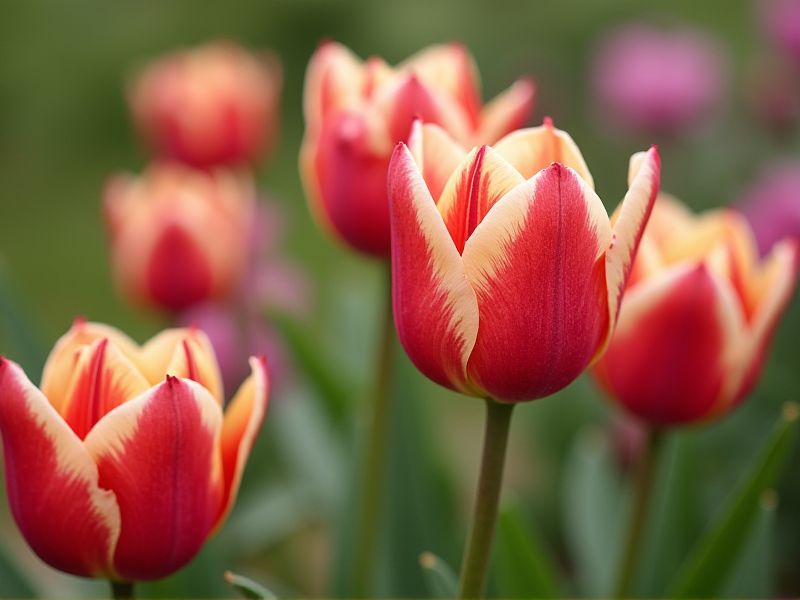
Spring-blooming plants, such as crocuses, daffodils, and tulips, are essential indicators of the season's arrival, often emerging as the last frost recedes. These perennial favorites not only add vibrant color to gardens but also attract pollinators, helping to support local ecosystems. You can enhance your landscape by incorporating these early bloomers, which thrive in well-drained soil and benefit from full sun exposure. The visual spectacle created by these flowers can uplift your mood and serve as a beautiful backdrop for outdoor gatherings. By selecting a diverse range of spring-blooming species, you ensure your garden remains lively and dynamic each year.
List of some Spring-blooming plants that herald
- Daffodil (Narcissus)
- Tulip (Tulipa)
- Crocus (Crocus)
- Primrose (Primula)
- Snowdrop (Galanthus)
- Hyacinth (Hyacinthus)
- Forsythia (Forsythia)
- Bluebell (Hyacinthoides)
- Magnolia (Magnolia)
- Cherry Blossom (Prunus)
Important things about Spring-blooming plants that herald
Ideal Planting Time
Spring-blooming plants such as tulips, daffodils, and hyacinths herald the arrival of warmer weather, creating vibrant displays in gardens. Typically, you should plant these bulbs in the fall, allowing them to establish roots before winter dormancy. In regions with milder winters, planting can also be done in early spring, as long as the ground is workable. Ensuring well-drained soil and adequate sunlight will promote healthy growth and abundant blooms as the seasons change.
Soil Requirements
Spring-blooming plants, such as tulips and daffodils, thrive in well-drained, fertile soil rich in organic matter. These vibrant perennials prefer slightly acidic to neutral pH levels, ideally between 6.0 and 7.0, to optimize nutrient absorption. Adding compost or well-rotted manure can improve soil structure and enhance moisture retention, providing the ideal environment for robust growth. To prevent bulb rot and promote early blooming, ensure good drainage by incorporating sand or perlite if your garden soil retains too much water.
Sunlight Preferences
Spring-blooming plants such as tulips, daffodils, and hyacinths thrive in full sunlight, making them ideal choices for vibrant garden displays. These plants typically require at least six hours of direct sunlight daily to support their rapid growth and stunning floral displays. Your garden layout should consider placing these sun-loving blooms in areas that receive ample light, ensuring they flourish during the spring season. Proper sunlight not only enhances their colors but also contributes to healthier growth, leading to a more spectacular seasonal showcase.
Watering Needs
Spring-blooming plants, such as tulips, daffodils, and hyacinths, thrive with specific watering needs essential for their vibrant growth. To ensure optimal blooming, you should maintain consistent moisture in the soil, avoiding both drought and waterlogging. Regularly checking the top inch of soil will help you determine when to water; it should be slightly moist but not soggy. As temperatures rise and your plants establish themselves, gradually decrease watering frequency, allowing the soil to dry out between sessions to promote healthy root development.
Common Spring Bloomers
Spring-blooming plants, such as crocuses, daffodils, and tulips, herald the arrival of warmer weather and vibrant color in gardens. These perennial favorites thrive in well-drained soil and require ample sunlight, making them ideal for early-season gardens. You can enhance your landscape by grouping these blooms together for a stunning visual effect that attracts pollinators like bees and butterflies. Their cheerful blossoms not only brighten your outdoor space but also signal the end of winter's dormancy and the start of a flourishing growing season.
Pest And Disease Management
Spring-blooming plants such as tulips, daffodils, and hyacinths signal the arrival of warmer weather but can attract various pests and diseases. You should monitor for common threats like aphids and slugs, which can damage foliage and buds, while fungal infections such as botrytis can lead to flower blight. Implementing integrated pest management (IPM) strategies, including natural predators and organic treatments, can effectively shield your garden from these issues. Regularly inspecting your plants, maintaining proper soil drainage, and ensuring adequate air circulation will promote healthy growth and vibrant blooms.
Fertilization Techniques
Spring-blooming plants, such as tulips and daffodils, thrive with specific fertilization techniques that enhance their growth and flowering capabilities. To optimize blooming, use a balanced fertilizer formulated for bulbous plants, ensuring nutrients like phosphorus promote robust root development and vibrant blossoms. Apply the fertilizer at the time of planting and again in early spring as new growth appears to supply necessary nutrients during peak growth phases. Your attention to soil pH is also critical; maintaining it between 6.0 to 7.0 encourages optimal nutrient uptake for these early bloomers.
Pruning Guidelines
Spring-blooming plants, such as forsythia, lilacs, and flowering dogwoods, thrive when pruned at the right time. To encourage robust growth and vibrant flowers, pruning should be done immediately after they finish blooming, typically in late spring or early summer. Removing spent blooms and dead or crossed branches not only improves air circulation but also fosters a healthier plant structure. By adhering to these pruning guidelines, you can ensure your spring-blooming plants remain lush and colorful year after year.
Companion Planting Benefits
Spring-blooming plants, such as daffodils and primroses, serve as excellent companions in the garden, providing aesthetic appeal while also enhancing biodiversity. These plants can attract beneficial pollinators like bees and butterflies, promoting a healthy ecosystem around your garden. Interplanting spring bloomers with vegetables or herbs can deter pests, reduce competition for nutrients, and improve overall plant health. By incorporating these vibrant flowers, you not only create a visually stunning landscape but also cultivate a flourishing environment for both flora and fauna.
Seasonal Maintenance Tips
Spring-blooming plants, such as tulips, daffodils, and hyacinths, signify the arrival of warmer weather and rejuvenate your garden with vibrant colors. During this season, ensure that you provide adequate watering as the soil begins to warm, promoting healthy growth and flowering. It's also essential to apply a balanced fertilizer to supply the necessary nutrients, helping your plants thrive as they awaken. Regular deadheading of spent blooms encourages prolonged flowering and keeps your garden looking neat and vibrant throughout the spring.
